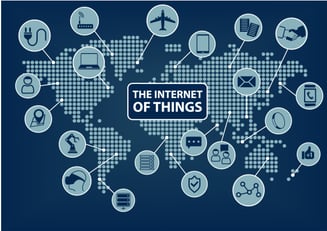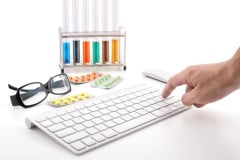"The most profound technologies are those that weave themselves into the fabric of everyday life until they are indistinguishable from it.”
- Mark Weiser
In 1990, when John Romkey connected an innocuous-looking toaster to the internet to demonstrate that it could be switched on or off with a computer, it was an indication that the time would come when internet connectivity would be possible without the need for continuous human intervention.
Well, it’s here and it's been labeled - the “Internet of Things”.

In 2010, the human population increased to 6.8 billion; with the growth of the smartphone industry in the last decade, the number of devices connected to the Internet has increased to 12.5 billion.That is more than one connected device (1.84 devices, to be precise) for one person!
By 2020, for every person, there will be 3 devices connected to the Internet!
Internet of Things (IoT) technology basically encapsulates the concept of total internet connectivity of devices, products and services along with sharing of data between them - with or without human intervention. Basically, many of the devices and utilities which you use will be interconnected, with you having to push less buttons than before. With its obvious benefits in the field of user applications, education, energy, healthcare and construction, the Internet of Things holds great promise and opens up a myriad of possibilities in innovation and experimentation.
These are a few of my favorite smart things...
The use of IoT technology has given the word ‘smart’ a whole new meaning.
In smart cities like Masdar in Abu Dhabi and Songdo in South Korea, IoT solutions aim to assist in the use of digital technology to improve urban services and reduce cost and resource consumption. The plan is to digitally connect everything in these cities from power grids, cars and buildings to utilities like the water supply, transportation, fire and security services and recycling of garbage.
And, you might not have to take out the trash after all!! The innovative garbage disposal system in Songdo has a vast network of underground tunnels and the garbage is sucked out of houses and office buildings and transferred to waste processing plants for recycling.
Automation Testing: Are You Ready to Start
Evaluate your automation readiness with Are You Ready to Start? — a practical guide to avoiding common pitfalls, scaling smart, and making automation work for your team.
I don’t feel like driving today….
Smart cars and smart homes are part of the blueprint for these smart cities. Smart cars not only talk to you, give you directions, tell you when to turn and when to stop - they also drive themselves and can even parallel park, thanks to radar, GPS and parking-assist systems! By the way, does that mean my 16 year old gets to ‘drive’ ?!! Hmm…
On a serious note, just think of how easy it would be for the physically challenged to move about and to not have to depend on public transport.
With the driver less cars on the road sharing data and learning from one another, experts say that each car already has 40 years of driving experience!
Hold a moment, my home is on the line
Product manufacturers from big companies to small startups have plans to dazzle you with ‘smart’ options for your smart home. From WiFi enabled baby monitors to ambient lighting to thermostat control to connected microwaves and washing machines, a variety of IoT solutions are already on the market.
IoT solutions for medicine
 Globally, the number of curable diseases is a fraction of the medical challenges faced by physicians everyday. As they struggle to find cures for diseases like Alzheimer’s and ALS (Amyotrophic Lateral Sclerosis), they need all the help they can get, be it resources in the form of money and materials or access to the latest information and research technology. The medical field stands to gain tremendously from IoT solutions; it may be as high-end software applications for research purposes or end-user applications like chip-embedded prescription bottles and ingestible pill sensors.
Globally, the number of curable diseases is a fraction of the medical challenges faced by physicians everyday. As they struggle to find cures for diseases like Alzheimer’s and ALS (Amyotrophic Lateral Sclerosis), they need all the help they can get, be it resources in the form of money and materials or access to the latest information and research technology. The medical field stands to gain tremendously from IoT solutions; it may be as high-end software applications for research purposes or end-user applications like chip-embedded prescription bottles and ingestible pill sensors.
Inside, outside
There is a lot of scope for IoT solutions in the construction business where safety and durability is a major concern. Construction tiles with embedded sensors for monitoring the quality and load-bearing capability of the structure are already in use. Cloud-based software which accesses tiny sensors via WiFi has made remote monitoring possible in places which are too dangerous or inaccessible (for instance, pipelines).
As you can see, the amount of devices in the field of IoT are exploding...here is one great location for a more in-depth preview of these advancements.
The advent of IoT has created some challenges...
- In fields like construction, transportation, security and healthcare where human lives are at stake, a malfunction at any stage of the IoT solution could be disastrous. If we say that automation and machine-to-machine connectivity has reduced the risk of human error, we must remember that it was human effort which made IoT technology possible and there is still the possibility of something going wrong at any stage.
- The large amount of personal data being shared between devices and applications has raised security and privacy concerns.
At a hackathon, an app called Makkie Klauwe, created by a student by the name of Bram Fritz, was showcased to demonstrate the risks of open data. It collated information about the areas with high income, low reported crime rate and broken streetlights, narrowing down the areas where it would be ‘safe’ for a thief to steal!!
- In their rush to get on the IoT bandwagon, companies are producing stuff which we don’t really need. For instance, the smoke alarm “Leeo”, which would normally have cost $20, has a $99 night light and is hooked up to the homeowner’s smartphone to alert them in case of fire. Would you want to spend as much on a fire alarm?
The real challenge today is to concentrate on those areas where IoT technology will actually help save on resources in terms of money, time and effort like the medical or aviation fields, with lasting benefits.
IoT has created new challenges for testing engineers as system integration and testing of IoT solutions involves multiple platforms, numerous protocols and a variety of APIs. It involves devices which will be of different classes, capabilities and standards. The local regulations on both the state and federal level, as well as international differences in both usage and language, must be adhered to and verified. The main challenge for testers to ensure proper software quality will be to not only keep up with both the physical and digital variations but to manage all the marketplace complexities while keeping up with the ongoing release at internet-speed.
Of course, with a growing plethora of devices, applications, and technologies the testing industry must embrace these changes. Existing software testing tools must evolve to include new technologies, and new tools developed to support excellent quality assurance and safety in these products.
Conclusion
The all-pervasive power of the Internet was correctly predicted by Neil Gross in 1999 when he said -
“In the next century, planet Earth will don an electronic skin. It will use the Internet as a scaffold to support and transmit its sensations.”
IoT aims at reducing human error and improve the quality of life by eliminating the need for constant human intervention among our daily tools. This is all well and good, and quite promising, but some important questions remain which I'd like to leave with you: How far does this go? Are we ready to give control to our daily devices and its embedded software to manage our lives? How will we as a human race respond once a majority of our machines are internet enabled and talking with one another?

